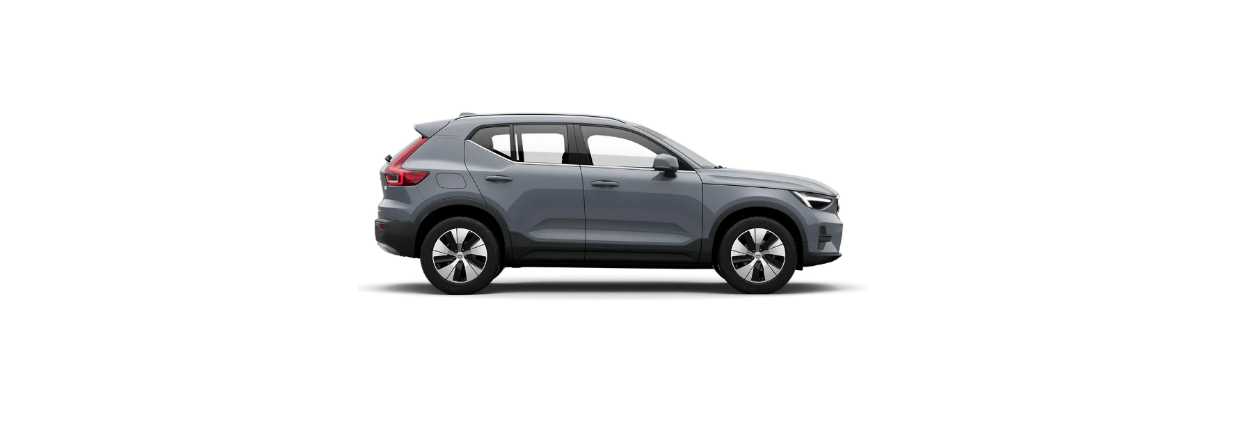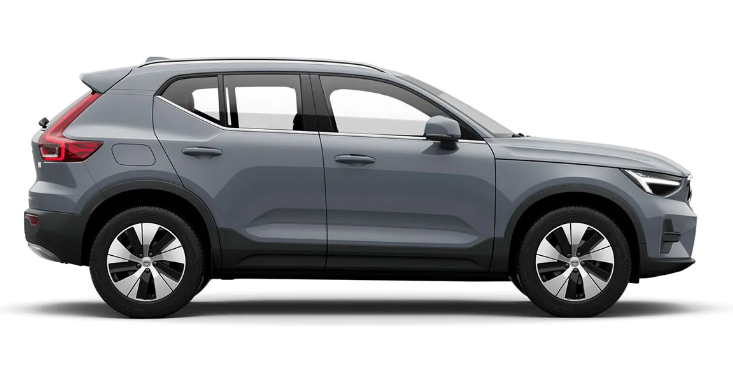The driver supports of adaptive cruise control and Pilot Assist have a special brake function in slow traffic and while stationary. In certain situations, the parking brake is applied in order to keep the car stationary.
Brake function in slow queues and while stationary
For shorter stops in connection with creep mode in slow traffic or at traffic lights, driving is automatically resumed if the stops do not exceed approx. 3 seconds – if it takes longer before the vehicle in front starts moving again then the driver support function is set in standby mode with automatic braking.
The function is reactivated in one of the following ways:
- Press the steering wheel button

 .
. - Depress the accelerator pedal.
The function resumes following the vehicle ahead if it starts moving forward within approx. 6 seconds.
Warning
- A significant increase in speed may follow when the speed is resumed with the

 steering wheel button.
steering wheel button. - Driver supports only warn of obstacles which their radar unit has detected – hence a warning may not be given, or it may be given with a certain delay.
- Never wait for a warning or intervention. Apply the brakes when the situation requires.
Note
- The driver supports can hold the car stationary for a maximum of 10 minutes – then the parking brake is applied and the function is disengaged.
- Before the driver supports can be reactivated, the parking brake must be released.
Cessation of automatic braking
In some situations, automatic braking ceases on coming to a standstill and the function is set in standby mode. This means that the brakes are released and the car may start to roll – the driver must therefore intervene and brake the car himself/herself to keep it stationary.
This may take place in any of the following situations:
- The driver puts his/her foot on the brake pedal.
- The parking brake is applied.
- The gear selector is moved to P, N, or R position.
- The driver sets the adaptive cruise control or Pilot Assist to standby mode.
Automatic activation of parking brake
The Parking brake is applied if the function is holding the car stationary with the foot brake and:
- The driver opens the door or takes off his/her seatbelt.
- The function has kept the car stationary for more than approx. 10 minutes.
- The brakes have overheated.
- The driver switches the engine off.
Setting the stored speed for cruise control functions
It is possible to set stored speed for the speed limiter, cruise control, adaptive cruise control and Pilot Assist functions.
Effect of the accelerator pedal
If the driver increases the car’s speed using the accelerator pedal before pressing the steering wheel button 
 (1), the speed stored will be the car’s speed when the button is depressed, provided the driver’s foot is on the accelerator pedal at the moment when the button is depressed.A temporary increase in speed with the accelerator pedal, e.g. during overtaking, does not affect the setting – the car returns to the last stored speed when the accelerator pedal is released.
(1), the speed stored will be the car’s speed when the button is depressed, provided the driver’s foot is on the accelerator pedal at the moment when the button is depressed.A temporary increase in speed with the accelerator pedal, e.g. during overtaking, does not affect the setting – the car returns to the last stored speed when the accelerator pedal is released.
Possible speed
Automatic gearbox
- The driver support functions can follow another vehicle at speeds from 0 km/h up to 180 km/h (112 mph).
- Pilot Assist can give steering assistance from almost stationary up to 140 km/h (87 mph).
- Note that the lowest programmable speed is 30 km/h (20 mph) – even though it is capable of following another vehicle down to 0 km/h, a speed lower than 30 km/h (20 mph) cannot be selected/stored.
Manual gearbox
- The driver support functions can follow another vehicle at speeds from 30 km/h (20 mph) up to 180 km/h (112 mph).
- Pilot Assist can give steering assistance from 30 km/h (20 mph) up to 140 km/h (87 mph).
- The lowest programmable speed is 30 km/h (20 mph) – the maximum speed is 200 km/h (125 mph).
Change of target with cruise control functions
The driver supports of adaptive cruise control and Pilot Assist, in combination with automatic transmission, have a change of target function at certain speeds.
Change of target
Warning
When the driver supports are following another vehicle at speeds
in excess of approx. 30 km/h (
20 mph) and the target is changed from a moving vehicle to a stationary vehicle, the driver supports will
ignore the stationary vehicle and instead accelerate to the stored speed.
- The driver must then intervene him/herself and brake.
Automatic standby mode with change of target
The driver supports are disengaged and set in standby mode:
- when the speed is below 5 km/h (3 mph) and the driver supports are uncertain whether the target object is a stationary vehicle or another object, such as a speed bump.
- when the speed is below 5 km/h (3 mph) and the vehicle ahead turns off so that the driver supports no longer have a vehicle to follow.
Setting time interval to vehicle ahead
It is possible to set the time interval to the vehicle ahead to be maintained by the adaptive cruise control and Pilot Assist functions.
Press the steering wheel button (1) or (2) to increase or decrease the time interval.
The distance indicator (3) shows the current time interval.Different time intervals to the vehicle in front can be selected and shown in the driver display as 1-5 horizontal lines – the more lines the longer the time interval. One line represents about 1 second to the vehicle in front, 5 lines represents about 3 seconds.The adaptive cruise control allows the time interval to vary significantly in certain situations in order to allow the car to follow the vehicle in front smoothly and comfortably. At low speed, when the distances are short, the adaptive cruise control increases the time interval slightly.
Note
When the symbol in the driver display shows a car and a steering wheel, Pilot Assist follows a vehicle in front at a preset time gap.When only one steering wheel is shown, there is no vehicle within a reasonable distance ahead.When the symbol in the driver display shows two cars, adaptive cruise control is following the vehicle in front at a pre-set time interval.When only one car is shown, there is no vehicle within a reasonable distance ahead.
- The higher the speed the longer the calculated distance in metres for a given time interval.
- Only use the time intervals permitted by local traffic regulations.
- If the driver supports do not seem to respond with a speed increase when activated, it may be because the time window to the vehicle ahead is shorter than the set time window.
Warning
- Only use a time window that suits the current traffic conditions.
- The driver should be aware that short time windows limit the amount of time available to react and take action in an unexpected traffic situation.
Warning from cruise control functions in the event of a collision risk
The driver support systems of adaptive cruise control and Pilot Assist can warn the driver if the distance to the vehicle ahead suddenly becomes too short.
Adaptive cruise control and Pilot Assist use approx. 40% of the capacity of the foot brake. If the car needs to be braked more heavily than the driver support is capable of and the driver does not brake, the warning lamp and acoustic warning are activated to alert the driver that immediate intervention is required.
Warning
The driver support systems only warn of vehicles which their radar unit has detected – hence a warning may not be given, or it may be given with a certain delay. Never wait for a warning. Apply the brakes when the situation requires.




